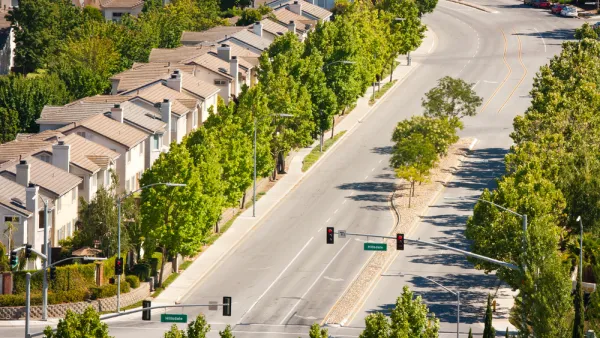Generalist Geoff Dyer delivers his walkability design tactics magnum opus on PlaceShakers. His years of practical experience are conveniently condensed for your consumption.
"As municipalities throughout North America seek to reform their development patterns (or at least expand their options) from the single-use zoning and automobile oriented regulations of the past century to those that allow for walkable, compact, mixed use places, there is a long list of standards and regulations that must be addressed. Often we discuss these issues in isolation, particularly the reform of use-based zoning into more responsive form-based zoning, and the reform of street standards from automobile-focused approaches to those that also balance the needs of bikes and pedestrians. Not only are these two regulations inextricably linked, but a roster of appropriate walkable street standards is absolutely essential to a form-based land use regulation. Where conventional zoning districts come with their own menu of street types (the ubiquitous local, collector, and arterial — all named for their vehicular function), so does the zoning for walkable urbanism (the street, avenue, and boulevard — to name a few)."
"Although the majority of our work on form-based regulations has been focused in the U.S., these ideas are increasingly catching on north of the border. While recently discussing this issue I was asked to convey what, in my experience, I have discovered as common considerations and issues when looking to create such standards in the Western Canadian context. Whether discussed in relation to a form-based code, or in isolation as 'walkable streets,' 'urban thoroughfares,' or (most popular), 'complete streets,' the truth is that many of the issues we face in Canada are the same as the ones we have faced in the U.S."
FULL STORY: Walkable Streets: Considering common issues

Analysis: Cybertruck Fatality Rate Far Exceeds That of Ford Pinto
The Tesla Cybertruck was recalled seven times last year.

National Parks Layoffs Will Cause Communities to Lose Billions
Thousands of essential park workers were laid off this week, just before the busy spring break season.

Retro-silient?: America’s First “Eco-burb,” The Woodlands Turns 50
A master-planned community north of Houston offers lessons on green infrastructure and resilient design, but falls short of its founder’s lofty affordability and walkability goals.

Test News Post 1
This is a summary

Analysis: Cybertruck Fatality Rate Far Exceeds That of Ford Pinto
The Tesla Cybertruck was recalled seven times last year.

Test News Headline 46
Test for the image on the front page.
Urban Design for Planners 1: Software Tools
This six-course series explores essential urban design concepts using open source software and equips planners with the tools they need to participate fully in the urban design process.
Planning for Universal Design
Learn the tools for implementing Universal Design in planning regulations.
EMC Planning Group, Inc.
Planetizen
Planetizen
Mpact (formerly Rail~Volution)
Great Falls Development Authority, Inc.
HUDs Office of Policy Development and Research
NYU Wagner Graduate School of Public Service




























